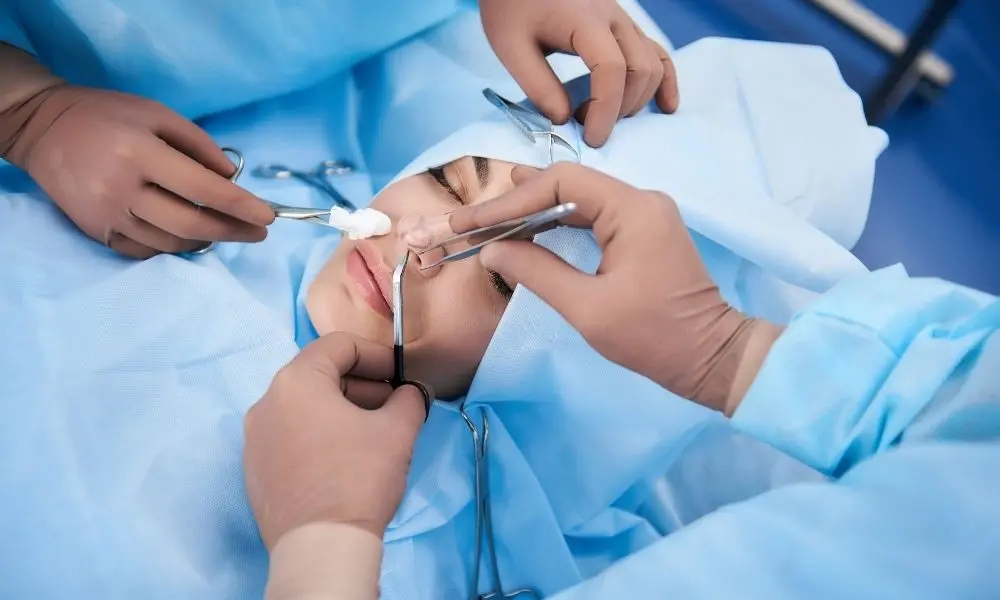Rhinoplasty Surgery
in Pimpri Chinchwad
Aren’t you happy with your regular nose shape, or do you feel unconfident about it? Don’t worry! We’ve got your back. Dr. Vrushali Nikam is the best surgeon for treating all your nose-related problems. Get into this article to learn more about rhinoplasty surgery in Pimpri Chinchwad.

What does a rhinoplasty surgery mean?
- Rhinoplasty surgery is commonly known as a nose job surgery.
- It’s a kind of cosmetic surgery that changes the shape and size of your nose. Some people get a nose job to make their nose and face look better.
- Some people get functional rhinoplasty, which makes it easier to breathe and makes their noses work better.
- Trained plastic surgeons or facial plastic surgeons perform this procedure.
Some of the conditions of the nose that can be treated with rhinoplasty surgery are as follows:
- Breathing problems
- Huge size nose or small nose
- Wide, Big, or tiny(narrow) nostrils
- Irregular and bent nostrils
- Bulbous nostrils
How do I prepare for rhinoplasty surgery in Pimpri Chinchwad?
The main goal of rhinoplasty surgery is to achieve the desired nose shape and have satisfactory results.
Before beginning the surgery, some tests are performed to study the structure of your nose, and then the procedure begins.
- A medical history
This is the most important step. Your medical history will be looked at, and then the next steps will be taken based on what was found.
This includes a history of nasal obstruction, surgery, and medications.
Note: If you have a bleeding disorder such as hemophilia, then your doctor may not recommend rhinoplasty surgery.
- Physical test
During a physical examination, laboratory tests (blood tests) are conducted for a complete checkup.
This includes checking the facial features of both the inner and outer parts of the nose.
In the same way, a thorough exam is done to figure out how rhinoplasty will affect your breathing.
- Photographs
Photographs of your nose are taken from different angles.
These photos are used as a reference during surgery (before and after assessments).
Therefore, this helps in having a further discussion about the surgery.
What is the procedure for rhinoplasty surgery?
Step 1:
General anesthesia
General anesthesia is given for sedation and is usually considered a pain-numbing medication.
The surgeon injects the anesthesia into the nasal tissues and sedates you with medication injected via an IV (intravenous) line.
This helps the patient remain unconscious throughout the procedure.
Step 2:
Incision
The incision is made in both open and closed rhinoplasty surgeries.
In contrast to open surgery, where the incision is made across the columella in tiny strips to spread out the nostrils, closed surgery conceals the incision.
Following the cut, the skin-covered nasal bones and cartilage are gradually lifted to alter the nose’s shape.
Step 3:
Reshaping nose structure
Bone or cartilage removal may be used to construct an excessively large nose. In some cases, cartilage grafts may be added during nose surgery.
The cartilage most frequently used for this purpose comes from the septum, the partition in the middle of the nose.
Sometimes, ear cartilage or rib cartilage can be used in this process.
Step 4:
Developing deviated septum
After this, the surgeon will create a septum deviation to straighten and reduce the projection inside it for better breathing.
Step 5:
Incision closure
The incision is closed once the desired nose shape has been achieved. (Additional incisions may be made in the natural creases of the nostrils for adjusting the size.)
What risk factors does rhinoplasty surgery include?
The rhinoplasty surgery includes risk factors such as:
- Infection – excessive swelling and redness can be an indication of infection.
- Bleeding – is one of the most common complications after a nose job surgery.
- A side effect of general anesthesia – Anesthesia is usually used for sedation or numbing the surgical site. But this can cause breathing problems after surgery.
- Permanent numbness – In open rhinoplasty surgery, there is a chance of permanent numbness in and around the nose region.
- Scarring – the nose job surgery involves an incision made, which can give rise to scarring on the nose part.
- No satisfactory result – In some cases, the patient may not be happy with their nose job or want to have another surgery to fix it again.
- (Note: At least wait for a year to let your nose heal from recent surgery)
- Pain – generally, pain in the nose and headache are more likely to occur after nose job surgery.
- Swelling and bruises – The initial stage of swelling after the surgery will be worse, but this usually lasts for 3–4 weeks, whereas bruises only last for 1-2 weeks.
- Discoloration – Skin discoloration is found in very rare cases, but if it occurs, it may be permanent.
- Septal perforation – A common complication that occurs when the nasal septum is perforated(hole).
What things should be avoided during the postoperative period?
The following things should be avoided to prevent additional complications after the rhinoplasty surgery:
- Swimming
- Blowing the nose
- Excessive Chewing
- Laughing, crying, or any facial expression that requires a lot of movements
- Strenuous physical activities
- Strong tooth brushing
- Resting eyeglasses on the nose
Our team of the best dermatologists at Bodysutra Clinic will make sure that the rhinoplasty is perfectly completed. Dr. Vrushali Nikam has more than seven years of experience and offers one of the best rhinoplasty surgeries in Pimpri Chinchwad. You can expect long-lasting and cost-effective treatments while working with us!
Book An Appointment
